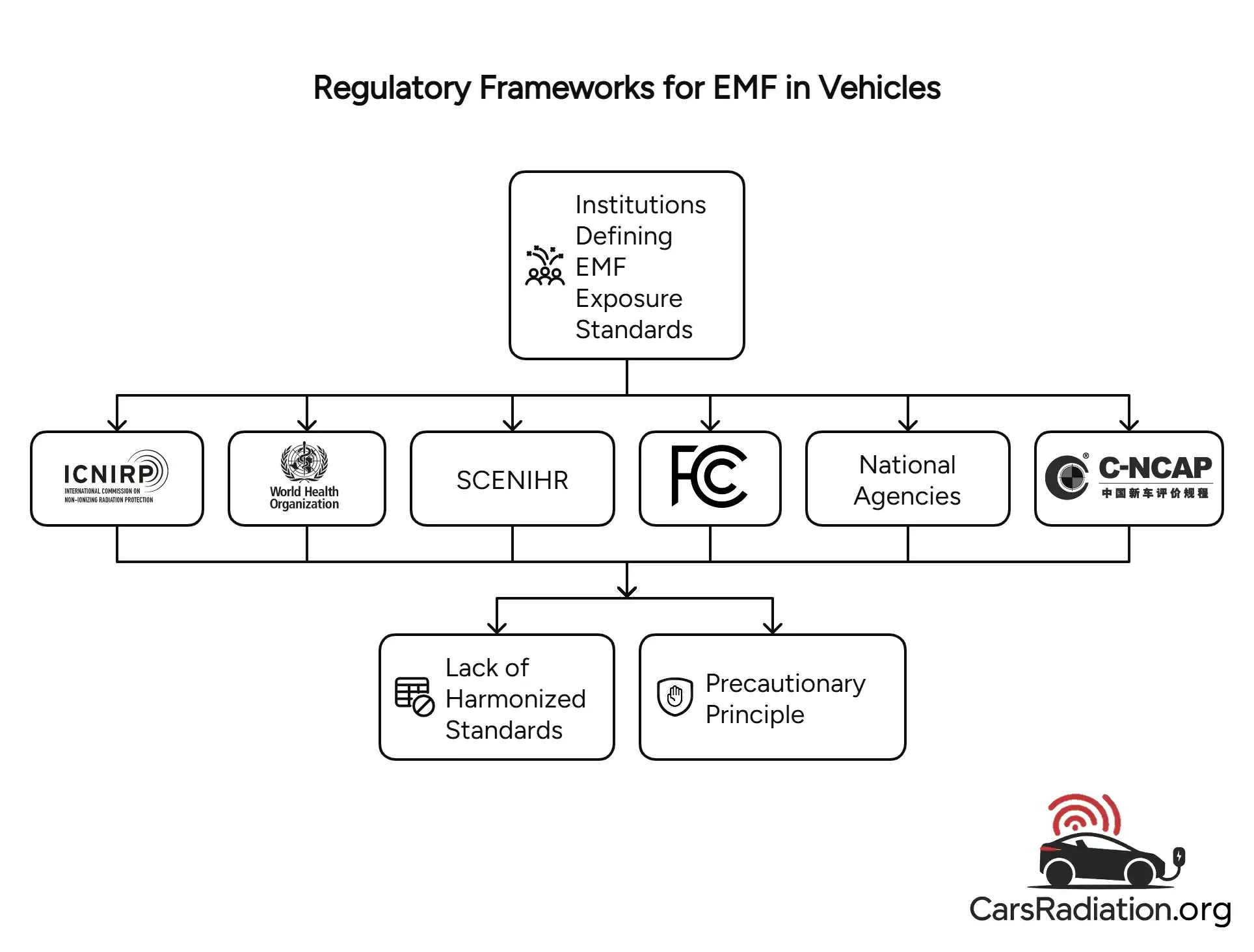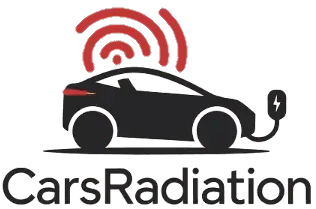Regulations on EMFs in Vehicles

The increasing penetration of electric and hybrid vehicles into global transportation markets has led to a change in both propulsion technologies and associated systemic risks. While these platforms are largely promoted for their reduced environmental footprint (primarily due to decreased tailpipe emissions), there exists a lesser-discussed byproduct: continuous exposure to electromagnetic radiation.
This exposure arises not from external sources but as a function of the vehicle’s internal electronic subsystems. As vehicle electrification progresses and the density of electrical components within the cabin increases, the relevance of regulating in-vehicle electromagnetic fields (EMFs) becomes a necessary consideration for public health and safety policy.
The following discussion addresses the nature of radiation within the modern vehicle context, outlines the applicable regulatory situation, and details the existing and emerging challenges in formulating protective standards.
Overview of Radiation in Modern Vehicles
Electromagnetic radiation in electric and hybrid vehicles is predominantly of the non-ionizing type and is generated as a consequence of standard vehicular electrical operation. The dominant contributors to in-cabin EMF exposure fall into three principal categories: static magnetic fields, extremely low-frequency (ELF) magnetic fields, and radiofrequency (RF) emissions. These are typically emitted by the following subsystems:
- Traction motors and auxiliary electric drives
- High-voltage traction batteries and associated busbars
- Power inverters and DC/DC converters
- Vehicle communication modules (Wi-Fi, Bluetooth, cellular)
- Onboard charging infrastructure and related control units
Numerous studies across multiple vehicle platforms and measurement methodologies have quantified ELF magnetic field exposure within vehicle cabins, with reported values ranging from 0.2 to 30 microteslas (µT). These values are largely dependent on specific vehicle architecture, component placement, shielding strategies, and driving state (acceleration, regenerative braking, etc.).
It is important to note that while such levels generally remain within the thresholds recommended by international guidelines, they reach or exceed limits under certain configurations or prolonged exposure durations, particularly for individuals seated in proximity to high-current pathways.
The interaction of ELF-EMFs with biological tissues is characterized by induction mechanisms, rather than ionization. However, these interactions particularly under low-intensity, chronic exposure scenarios are not yet fully characterized.
Documented effects in literature include disruption of melatonin secretion, sleep disturbances, and altered cellular signaling pathways. More significantly, epidemiological data suggest correlations with increased cancer risk, particularly childhood leukemia, when long-term exposure exceeds 0.4 µT.
Although causality remains a subject of scientific debate, the precautionary principle has been invoked by several health authorities in light of accumulating data on possible sub-thermal biological effects. Vulnerable populations (pregnant women and children among them) may face increased susceptibility to such fields due to differences in physiology and developmental stage.
Continued research is needed to both refine exposure models and update regulatory thresholds. However, the variability in exposure levels between vehicle models (and even seating positions) underscores the importance of implementing engineering controls and standardized measurement protocols during vehicle development.
Regulatory Frameworks for Electromagnetic Fields (EMF) in Vehicles
Institutions Defining EMF Exposure Standards
Multiple institutions, international, regional, and national, participate in defining permissible limits for electromagnetic field (EMF) exposure. These bodies differ in scope but collectively influence regulatory policy relevant to electric and hybrid vehicles.
- ICNIRP (International Commission on Non-Ionizing Radiation Protection): Provides globally recognized guidelines for general public and occupational exposure to time-varying electric and magnetic fields. Its 1998 recommendations, and more recent updates, are widely referenced by public health authorities and industry.
- World Health Organization (WHO): Through its Environmental Health Criteria monographs and IARC classification, WHO has contributed substantial assessments regarding potential health effects of extremely low-frequency (ELF) magnetic fields. Notably, ELF fields were classified in 2002 by IARC as “possibly carcinogenic to humans” (Group 2B), based on epidemiological studies linking chronic exposure to childhood leukemia.
- SCENIHR (Scientific Committee on Emerging and Newly Identified Health Risks): Operates under the European Commission, evaluating health risks from EMF across EU member states, including vehicle-based exposure scenarios.
- FCC (Federal Communications Commission): Regulates radiofrequency emissions in the United States, including emissions from vehicular electronic systems such as wireless connectivity and infotainment units.
- National Agencies: Examples include Germany’s Bundesamt für Strahlenschutz (BfS), France’s ANSES, and Israel’s Ministry of Health. These agencies conduct region-specific EMF risk assessments and publish precautionary recommendations.
- C-NCAP (China New Car Assessment Program): China has become the first country to formally include in-cabin EMF benchmarks in its vehicle safety rating protocol. This development sets a precedent, and other NCAP programs (Europe, Korea, ASEAN) are expected to follow suit, integrating EMF criteria into consumer vehicle assessments.
While the primary exposure metric remains a 100 μT threshold for ELF fields, the lack of harmonized, mandatory vehicle-specific standards makes it difficult to apply this uniformly across markets. Benchmarking efforts like China NCAP may serve as a reference point for emerging global protocols. Many also endorse the Precautionary Principle, to advise forward-thinking mitigation in cases where scientific certainty is incomplete but potential health risks exist.

Vehicle-Specific Regulatory Measures
While EMF regulation in automotive contexts remains under development, several test procedures and mitigation strategies have emerged:
- Shielding Requirements: Vehicle powertrain components (inverters, battery cables, DC/DC converters) are increasingly subject to design constraints aimed at minimizing leakage fields. This includes the use of ferrites, shielded enclosures, and optimized return paths.
- Measurement Protocols: Cabin-level EMF assessments are conducted using isotropic probes and dosimetric sensors placed at head, torso, and foot locations in dummies or live measurements during drive cycles. Standardized procedures remain inconsistent across jurisdictions.
- Compliance and Certification: While ICNIRP and IEEE standards are often applied in pre-market testing, these are not mandated in all regions. The European Union’s Joint Research Centre (JRC) has issued recommendations for harmonized vehicle EMF testing, with emphasis on repeatability and relevance to real-world conditions.
Vehicle approval processes increasingly include EMF compliance as part of broader electromagnetic compatibility (EMC) evaluations, yet no binding global standards currently exist specifically for long-term cabin exposure.
General EMF Safety Guidelines with Automotive Implications
Though not written explicitly for vehicular application, broader EMF health criteria often influence automotive system design:
- ICNIRP Guidelines (1998, 2010, 2020): Used as default exposure thresholds across multiple sectors, including transport infrastructure.
- WHO Environmental Health Criteria 238: Provides foundational understanding of ELF-MF biological effects across exposure environments.
- BioInitiative Report: Offers a more conservative interpretation, arguing for substantially lower thresholds due to observed bioeffects at sub-ICNIRP levels especially concerning for continuous exposure environments like car cabins.
These broader standards are variably transposed into national regulations. For instance, some countries impose additional restrictions on EMF-emitting subsystems, including wireless keyless entry, Bluetooth, or Wi-Fi modules within vehicles.
EMF Measurement Standards and Benchmarking
A standardized methodology for the assessment and regulation of electromagnetic fields (EMF) in vehicles is important, given the wide variance in powertrain configurations and real-world usage scenarios. The following table outlines a comparative overview of currently adopted standards relevant to EMF measurement in both automotive-specific and broader electromagnetic exposure contexts:
| Standard/Body | Field Type | Frequency Range | Limit for Public Exposure | Vehicle Relevance | Notes |
| ICNIRP (2020) | ELF Magnetic | 1 Hz – 100 kHz | 100 µT | High | Common benchmark in vehicle design |
| IEEE C95.1 | ELF & RF | Up to 300 GHz | 83.3 µT @ 50 Hz | Moderate | Often referenced in R&D testing |
| WHO EHC 238 | ELF Magnetic | Broad | Advisory only | Moderate | Basis for precautionary frameworks |
| China NCAP (2024) | ELF Magnetic | ~0–300 Hz (vehicular) | ≤30 µT (cabin target) | Very High | Emerging benchmark for consumer ratings |
| BioInitiative Report | ELF & RF | Up to GHz range | 0.3 – 0.4 µT (recommendation) | Low | Not adopted by regulators; used for advocacy |
| JRC (EU Joint Research Centre) | ELF Magnetic | 5 Hz – 10 kHz | Varies by test protocol | High | Promotes harmonized EU vehicle testing protocols |
Challenges and Evolving Considerations in EMF Regulation
Measurement Uncertainty
In-vehicle EMF exposure measurement remains a technically complex task. Field strength is sensitive to a wide range of parameters:
- Battery Positioning: Underfloor battery packs or rear-mounted units alter exposure profiles near passenger extremities.
- Cable Routing: Proximity of high-current cables to seating areas correlates strongly with peak magnetic field values.
- Drive Cycle Influence: Acceleration, regenerative braking, and charging introduce transient field spikes, varying by model.
- Test Methodology: Laboratory measurements often differ significantly from dynamic, real-world scenarios due to environmental and operational variables.
These factors introduce variability that complicates the establishment of enforceable regulatory thresholds.
Technology Evolution Outpacing Regulation
Modern vehicles increasingly integrate multiple EMF sources: onboard chargers, wireless charging pads, 5G antennas, and autonomous navigation systems. This multi-frequency, multi-source environment presents a regulatory blind spot.
Existing standards do not account for cumulative exposure across ELF, RF, and intermediate frequency ranges. Regulatory lag, common in emerging technologies, may delay risk mitigation until adverse health outcomes are confirmed.
Vulnerable Populations and Cumulative Effects
Preclinical data suggests that long-term exposure to ELF-MF may impact immune regulation, oxidative stress levels, and even body mass in animal models. Particularly concerning is the potential susceptibility of:
- Children: Longer exposure duration over a lifetime, combined with greater biological sensitivity during development.
- Pregnant Occupants: Possible association with miscarriage and fetal growth parameters, as highlighted in epidemiological studies (e.g., Li et al., 2002).
These findings underscore the necessity of not only average exposure limits but also special considerations for at-risk groups.
Regulatory Outlook
Emerging consensus points to several strategic actions:
- Standardization of Test Conditions: Harmonized methodologies are needed for in-vehicle EMF assessment, both static and in motion.
- Mandatory Disclosure: Labeling of average and peak EMF emission levels may aid consumer awareness and choice.
- Design Modifications: Implementation of counter-phase magnetic field cancellation or re-routing of high-current paths to reduce in-cabin exposure.
- Public Education: Raising awareness of non-thermal biological effects and promoting informed use of vehicle technology.
Future regulatory frameworks must transition from acute safety assurance to chronic exposure risk evaluation, integrating long-term biological endpoints.
The electrification of mobility, while critical for decarbonization, introduces complex electromagnetic exposure scenarios not fully addressed by current regulation. The evidence base, though still evolving, justifies a precautionary approach particularly for prolonged, low-level exposure environments like vehicle cabins.
Stronger, vehicle-specific standards, paired with transparent testing protocols and public engagement, are needed. Bridging the gap between innovation and public health will determine whether electric transportation delivers not only environmental benefits, but also human safety.

